I have been waiting to return to San Juan Island for 5 years. The first time I came to Friday Harbor, I was 15 years old. I arrived in Washington with the hopes of seeing a wild orca, and I began my hunt on the ferry to the island. I stood on the chilling bow, wind-whipped and shivering in 4 layers of clothing, scanning the horizon for black dorsal fins and telltale plumes of mist suspended in the air. I knew the chances of seeing whales before I had even reached San Juan Island were slim, but I simply could not contain my excitement. About halfway through the ferry ride, I noticed a zodiac idling a mile or so away. The people on the boat were obviously looking at something, and I squinted my eyes to get a better look. Moments later, a black shape rose out of the water, and my heart skipped a beat – orcas. Somehow my father managed to snap a photo of me at this exact moment, and I can only describe the expression on my face as one of pure, unadulterated joy. In suburban Ohio where I grew up, the closest thing to wild orcas are captive animals who lead sad half-lives at Sea World; it was an absolute thrill to see these animals swimming freely in the Salish Sea. This unexpected encounter set the trend for the remainder of my trip – I saw orcas nearly every day. I watched whales cruise by the lighthouse at Lime Kiln State Park and I followed them through the fog on a whale watch. The only way I managed to leave the island without dissolving into tears was to promise myself that I would return someday.
As I boarded the Anacortes ferry one week ago, I was overcome with the same child-like excitement I felt during my first ferry ride. I had waited so long to be reunited with this thick, fragrant air, the ethereal cathedrals of tall, leaning trees, and, most of all, the whales. After seven days on the island, I have still yet to see an orca, but my disappointment has been tempered by a multitude of other wildlife experiences. Friday Harbor Labs is situated within a biological preserve, and the area is bursting with life. I have had close encounters with deer, sea lions, slugs, foxes, and river otters, temporarily satiating my desire for animal contact. I have started to use our Sibley’s bird guide to identify the birds around our duplex (including a Red-Shafted Northern Flicker that has been drilling noisily on a metal lamp outside our window for the past few days) in an effort to hone my observational skills. While these experiences have been fulfilling, there is still part of me impatient to get out on the water – I listen to the hydrophone network daily, ears tweaked for sweeping killer whale calls, and even though I know they don’t frequent the east side of the island, I keep an ear out for the gunshot ring of whales coming up for air. We’ll be out at sea in two short weeks; in the meantime I will enjoy the company of other creatures and bask in the knowledge that I am finally back in this wonderful place.
Read More
3/29
Today we went on a field trip to Lime Kiln State Park on the west coast of San Juan Island. The weather was typical PNW spring weather when we arrived at the lighthouse, sunny and breezy. It was chilly but nice. We were tasked with thinking of 21 questions, which captured our interest, to do with orca and the environment they live in.
When time was up and we were heading back to the lighthouse from our various inspirational areas, we saw a sea lion. It was very cool. We couldn’t tell what type it was, mainly because we only saw a bit of its head once or twice, but Kathryn thought it was a stellar or California sea lion.
In the lighthouse we eat lunch as a group and talked a bit about our interests, which in turn sparked some discussion about what kind of research has been done and was being investigated currently. That was pretty interesting and allowed us to get a better idea of what were feasible topics for our areas of study.
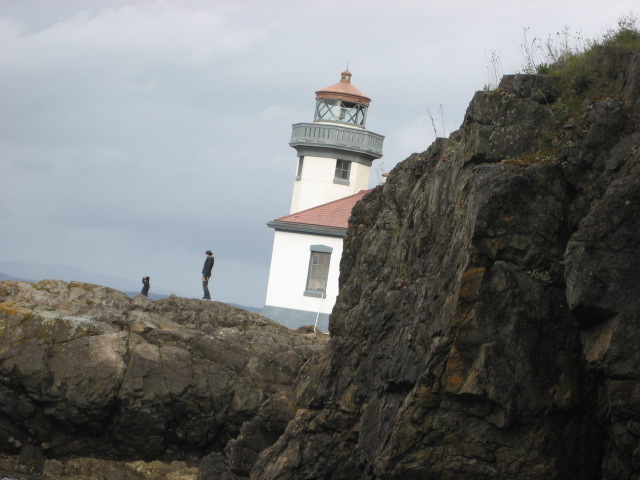
The lighthouse at Lime Kiln State Park
3/31
Today we did acoustics. It was awesome. Val showed us how to use some of the sound recording and analyzing equipment. Then we did our own experiments to figure out what we were seeing on the computer and how to change the amount of reflected sound the microphone was receiving from the wall behind it. Â We used a pillow and a glass bowl! We were also able to work out some of the basic calculations to find the speed of sound, which we managed to get very wrong. It was a lot of fun to see how every thing worked from the ground up.
After Val left Jason taught us more about the technical and mathematical side of acoustics so we would understand more of the jargon as well as the equations and parts of sound, like amplitude (volume) and frequency (pitch). We also got to see how sound waves canceled each other out and made each other louder with a very cool computer program he used. Â It was fascinating to first use a hands-on approach to figure out how the simple stuff worked so when we learned about how the more complex things worked it all made sense and fit together.
After lunch we got to meet with Jason to discuss our questions that we want to focus on for our research topics, which was cool. I am finding it very difficult to hone my interests into one narrow researchable field.
4/1
Today we got a great talk from a lady named Lynn. She is a beacon of hope for all people, like me, who struggle with writing. I have never, before today, been excited to write something or understood what was really expected of me. She was very good at explaining what was expected for both our research proposals as well as our final papers in a very no-nonsense and explicit manner. It was delightful!
After Lynn left we discussed a paper about the effects of sound exposure on the southern resident killer whale community. It never ceases to amaze me that for every decision, action or lifestyle choice we make there are hundreds of other living creatures strongly, and most of the time adversely, effected.
I am excited about the service project. I am still trying to decide between volunteering at a wildlife rehabilitation shelter called Wolf Hollow or at the whale museum working as an educational helper.
For the last few days we have been plagued by a strange and very fast metallic hammering noise, the source of which remained a great mystery. Today we finally found who was responsible, through the enthusiastic sleuth work of Kathryn! It turns out that it was a Red-shafted Northern Flicker (a type of woodpecker), which was pecking on a metal streetlight cover. I looked it up and found that many woodpeckers peck on metal during seasons when they want to establish territories and attract mates. It is kind of amusing watching the little guy peck on the light.
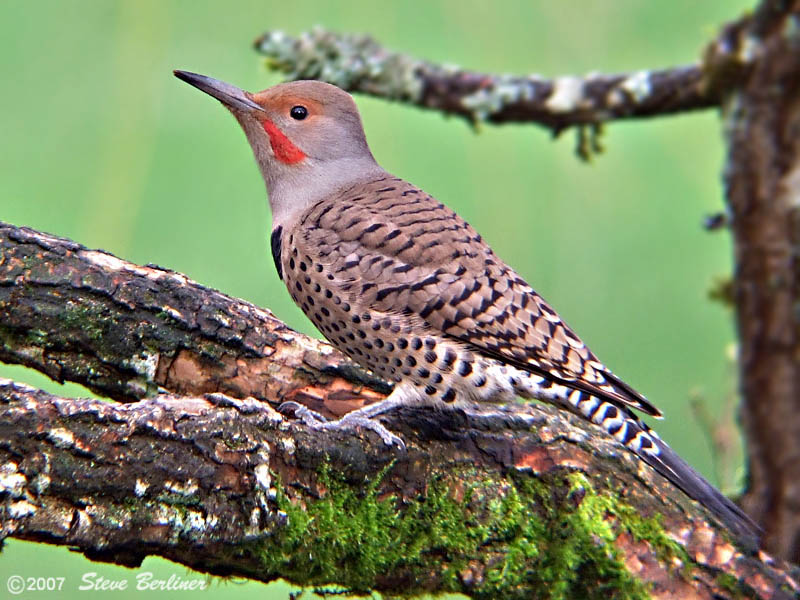
Red-shafted Northern Flicker
4/2
Today was blustery to say the least. We had gusts up to 45 mph!
Upon our return from breakfast, we discussed a really cool paper about some of the concerns the AEI (Acoustic Ecology Institute) has as well as some of the new technologies that were being utilized and invented last year. During the discussion the power went out, so after we finished we went down to the computer lab, as it was one of the only buildings with power and internet, to acquire the applications that will help us analyze our eventual sound data. My favorite is a program called RavenLight. The programs we got allow us to look at sounds. It’s really fun!
It was still really windy when we were walking to lunch. Val and Jason mentioned that they should probably check on the state of the ‘Buzzard’, a boat whose purpose is to collect dead samples, to make sure the wind hadn’t blown it away. When we got down to the dock we realized that the winds were so strong that the waves were washing over the dock. The boat was moving around pretty good causing the mooring rubbing against the dock lines to fray. They fixed the lines pretty fast and we went to lunch.
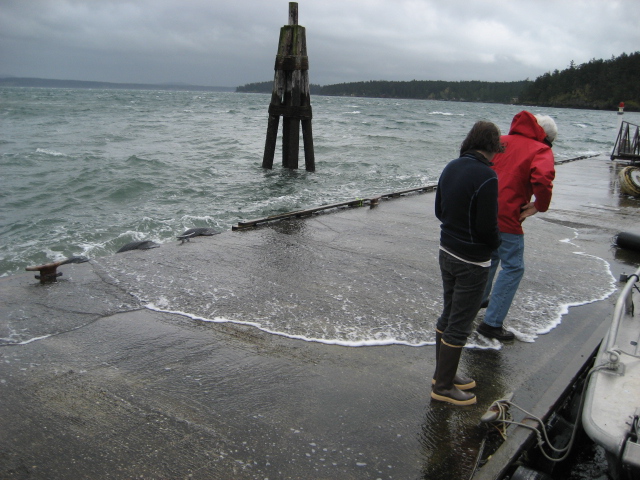
Me and Val on the dock next to the “Buzzard” as the waves wash over.
After lunch we finished our lecture on acoustics, which was really awesome because we got to listen to a bunch of different animal calls and see them on the spectrogram (the thing that lets you see the sound). We could see the amplitude modulation as well as the frequency modulation (change in volume and pitch).
During our lecture we saw two river otters running down towards the water and I managed to get a few good shots.
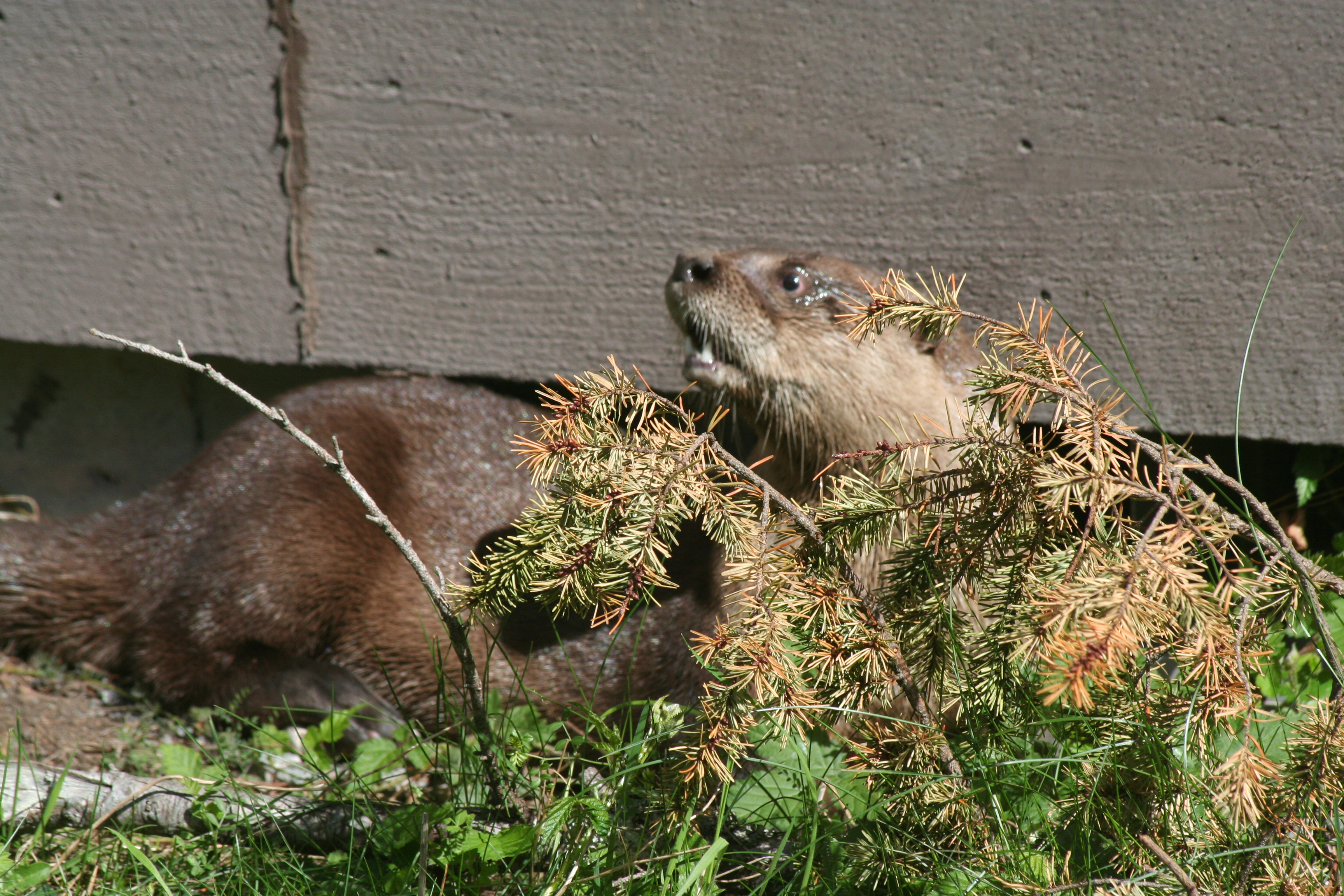
Tomorrow we have our first day off and are planning to go to the whale museum. Everyone is really excited.
4/3
Today we went to the Whale Museum! It was really cool. They had a lot of different exhibits including some very fun ones for kids. There were also a few skeletons, which really showed the incredible size of the animals!
When we left the museum it had been hailing like crazy. The ice balls were huge, about the size of small peas! It was pretty wild to come out of the museum and see the ground covered in white with small rivers of water running hear and there.
We walked around town for a bit and had lunch at a really good Syrian restaurant. Overall it was a good relaxing day after a fun but hard first week.
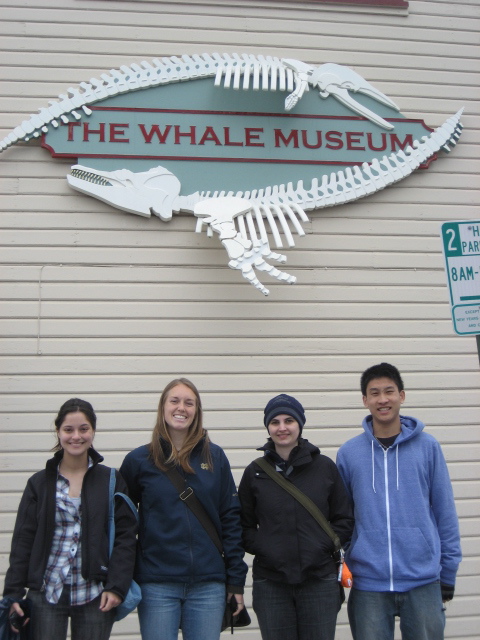
Kathryn, Libby, Me and Horace
Read More

Juvenile rockfish at the Seattle Aquarium
It was a great pleasure to meet the four incoming students for the spring 2010 program last Sunday (3/29). Libby, Kathryn, Horace, and Nora all arrived safely in Seattle in time for a 10:30 tour of the Seattle Aquarium. We saw Pacific salmon and rock fish in the new big outer coast tank, noticed a drift wood log snagged on the cable when viewing the hydrophone station behind the scenes, and listened to underwater sounds and John Ford videos down in the orca exhibit.
After a quick lunch of crumpets and salmon jerky and a brisk walk through Pike Place Market, we drove northward in a caravan just after 13:00. We dodged Seattle traffic detours and light rain to make the 14:45 ferry with just 5 minutes to spare. Amazed that both of our cars got the final two center lane (first off) spots on the ferry, I declared it an auspicious entry into the Archipelago!
Here is a link to the spring 2101 class home page. There you will find more information about the new students, their instructors, and the adventures upon which they are embarking.
Read More








 Twitter
Twitter LinkedIn
LinkedIn Facebook
Facebook